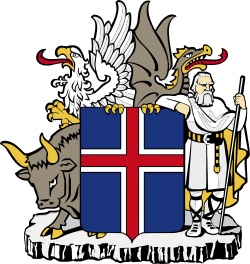1949 anti-NATO riot in Iceland
 |
| This article is part of a series on the politics and government of Iceland |
| Constitution |
|
Institutions |
|
|
Politics portal |
The Icelandic NATO riot of 30 March 1949 was prompted by the decision of Alþingi, the Icelandic parliament, to join the newly formed NATO, thereby involving Iceland directly in the Cold War, opposing the Soviet Union and re-militarizing the country.
The protesters first convened behind a school in the centre of Reykjavík and then marched on Austurvöllur, a small park in front of the parliament building, where a throng of people had already arrived positioning themselves between the parliament and the rioters, intending to defend it.
At first the demonstrators were calm, but when a leading member of the Socialist Party announced over a loudspeaker that the leader of his party was held hostage inside the Parliament building, things became violent.
Rocks were tossed at the building, some breaking the windows and one narrowly missing the head of the Parliamentary president, until the Reykjavík police force, aided by volunteers from the Independence Party intervened, beating rioters down and eventually launching tear gas grenades at the rioters.
No official estimate exists of the number of participants, but photographic evidence clearly shows that thousands of people were present.
Aftermath

The details of this event have largely been obscured by opposing opinions and lack of neutrality in discussion. Despite violent opposition, Iceland's membership in NATO was confirmed.
After the event, protests by anti-NATO activists were commonplace. The left parties in 1950s and 1960s parliamentary elections promised to put an end to the bilateral U.S.-Icelandic Defence Agreement but dropped these promises after becoming part of the ruling coalitions.[1] The slogan "Iceland out of NATO and the Army out!" ("Ísland úr NATO og herinn burt!") became a part of Icelandic culture. It has however largely lost its meaning after 2006 when the US Navy left the military base that had been run at Keflavík airport since the end of World War II (Icelandic diplomat Einar Benediktsson points out that in fact the decision to end the American military presence in Iceland was taken at the United States in early 1990s and it was the Iceland government who persuaded the U.S. Air Force to stay for another decade or longer[1]).
Right-leaning historians, such as Þór Whitehead, consider the riot as an attempted coup d'état by the communist minority. The failure of the coup d'état is then generally attributed to the number of civilians willing to protect the parliament and the skills of the Icelandic Police who had, just a few years before, pacified the Victory Day riot in 1945 where thousands of Allied soldiers and sailors went berserk in Reykjavík, celebrating the victory over Nazi Germany.
-

People gather in front of the House of the Althing.
-

Police are prepared for trouble in front of the House of the Althing.
-

Overview over Austurvöllur, in front of the House of the Althing
-

Overview over Austurvöllur and the House of the Althing.
-

Overview over Austurvöllur, Reykjavik Cathedral and the House of the Althing.
-

People gather for a meeting at the old school, by Tjörnin in downtown Reykjavik
-

In the throng in front of the House of the Althing during anti-NATO protests.
-

Fighting breaks out between anti- and pro-NATO supporters, and police. The windows of the House of the Althing have been smashed.
-

People flee from tear gas unleashed by police.
-

Policemen in gas masks guard Austurvöllur after dispersing the crowd with tear gas.
References
- ↑ 1.0 1.1 Einar Benediktsson. (August 18, 2011). "At Crossroads: Iceland's Defense and Security Relations, 1940-2011". Strategic Studies Institute. Retrieved 2013-09-06.
See also
- Alþingi
- Angels of the Universe (a novel whose protagonist is born during the riot)
- Kitchenware Revolution